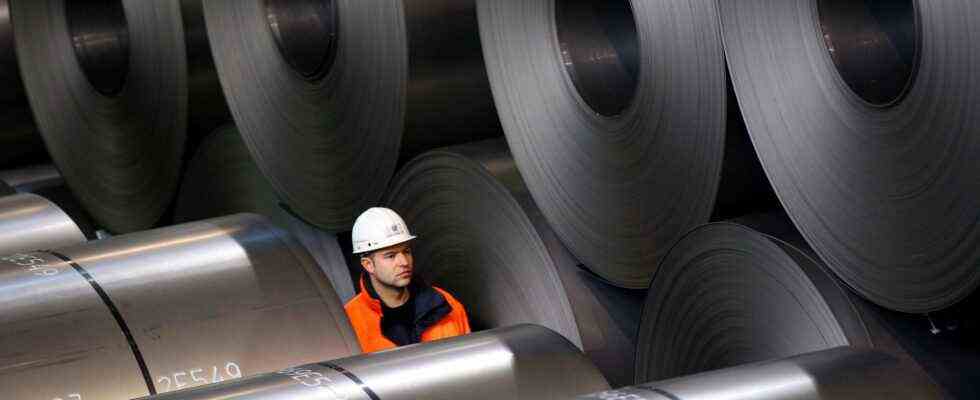As of: 09/22/2021 1:32 p.m.
Following the OECD, the ifo Institute has also revised its growth forecasts for Germany downwards. The reason are the delivery bottlenecks. The industry in this country plays a prominent role.
The recovery of the German economy from the Corona crisis will be weaker than the government and economists expected a few months ago. After the OECD, the Munich Ifo Institute has now also lowered its growth forecast to 2.5 percent. That is 0.8 percentage points less than previously forecast. “The strong recovery after Corona, which was originally expected for the summer, continues to be postponed,” said Ifo Economic Director Timo Wollmershäuser.
The sudden increase in global demand for durable consumer goods, electronic items and specialty medical products has pushed many manufacturers to their capacity limits. “In addition, the global supply chains were confronted with enormous logistical challenges as a result of greatly changed flows of goods,” emphasized Wollmershäuser.
Strong upswing expected next year
While production is stagnating, the service providers are doing better again. The increase in employment there accelerated strongly in the second quarter. “The economy is divided,” said Wollmershäuser. The number of unemployed is expected to fall to 2.6 million this year and 2.4 million in 2022. “Short-time working was also noticeably reduced and will reach its pre-crisis level in the coming year,” the economic researchers predicted. The inflation rate is likely to rise to 3.0 percent this year, and for the coming year the institute expects an inflation rate of 2.3 percent.
In the coming year, industry should also recover and give the entire economy new impetus. For 2022, the ifo experts now expect growth of 5.1 percent, 0.8 points more than last forecast. The national deficit – the new debt of the federal government, states, municipalities and social security funds – will decrease from 157 billion euros this year to 52 billion euros. For 2023, the economic researchers even expect a balanced state budget.
The chief economists of the private banks are also optimistic for next year, they predict a consumption boom in Germany. “We expect private consumption to increase by seven percent in 2022,” said the chief executive of the BdB banking association, Christian Ossig, about the autumn forecast. “That would be by far the strongest increase since reunification.” The forced saving through Corona – when consumers could not shop as usual during the lockdowns and cultural and leisure offers were severely restricted – seem to be over. The catch-up effects should continue into next year.
Debt ratio lower than anywhere else
What remains is a high level of debt. According to the Bundesbank, the corona pandemic swelled German national debt by 275 billion euros to 2.332 trillion euros last year. In the previous years, however, debts had been repaid. The debt ratio, i.e. the debt level in relation to gross domestic product (GDP), rose by 10.3 percentage points to 70 percent in 2020. “This is the strongest increase in the debt ratio within a year since reunification,” said the Bundesbank. A year earlier, at 59.7 percent, Germany fell below the reference value of the Maastricht Treaty of 60 percent for the first time since 2002.
Nevertheless, Germany is still in a better position in an international comparison. The debt ratio in Italy has climbed to 155 percent of economic output. In France (115 percent) and the USA (131 percent), too, debt exceeds economic output. The figures show that the tax revenues in these states are insufficient to finance the necessary expenditure and investments. So the countries have to borrow money.
Still an industrial nation
Is the German economy threatened with decline after the golden years between 2010 and 2019? The British business magazine “The Economist” recently issued a fatal testimony to Germany as a business location and predicted major problems for entire industrial sectors such as car manufacturers. It was mostly industry that had increased Germany’s prosperity in recent years.
In fact, when compared internationally, Germany is still an industrial nation. With sales of a good 2,000 billion euros in 2020, it is the fourth largest producer of industrial goods in the world. Last year, the share of manufacturing and industry in value added (GDP) was 19.7 percent, ahead of Japan (19 percent) and well ahead of the USA (11.1 percent), France (10.5 percent) or the United Kingdom (9.3 percent). 6.2 million people are directly employed in industry. Because many company-related services also depend on industry, experts assume that 40 percent of added value is generated directly and indirectly by industry. “The people who keep the store running work here,” said Evonik boss Christian Kullmann of the “FAZ”.
An oppressive tax burden
Most workers, however, have to live with an overwhelming tax burden. An average earner in Germany has to give up almost half of his gross wage (49 percent). Only in Belgium (51 percent) is the rate even higher. For comparison: in Switzerland the average tax burden is 22.1 percent, in the USA it is 28.3 percent. When it comes to the tax burden, Germany is even at the top in an international comparison, with 29.9 percent, ahead of Japan and Italy.
From the point of view of companies, the country also has other weaknesses: In addition to the high wage tax rate, business associations and economists criticize the bureaucratic hurdles and the associated costs as clearly too high. The Association of the Chemical Industry (VCI) puts the annual administrative costs at more than 50 billion euros. Another shortcoming from the industry’s point of view is the poor creditworthiness of the domestic banks and their fragmented structure. The country also has major weaknesses in the digital sector.

